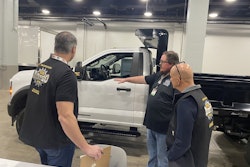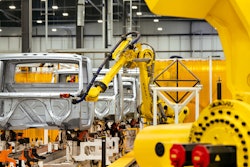While many shops pay service technicians by the hour, Darry Stuart expresses their value another way. A simple calculation, he says, will show that an average technician’s time is worth at least $1 a minute.
Think about how that equates to lost revenue if time is wasted searching the shop for tools, parts and supplies.
As important as the volume of work may be, profit margins are largely dictated by the efficient use of every employee. In a typical shop, nearly 90 percent of a technician’s time should be billed back to a customer, says Stuart, who counsels shop managers through DWS Fleet Management Services. Even an eight-person shop that services a wide variety of vehicles should be turning wrenches more than 80 percent of the time.
This may seem to leave plenty of time to address the other tasks that fill a workday, but consider how quickly the minutes can tick away between one job and the next: A technician asks the service manager about the next truck that needs to be repaired (tick); cleans up, grabs the keys and heads to the lot (tick); finds the vehicle and jockeys the truck (tick, tick); pulls inside the bay doors (tick); gets his tool box and opens the hood (tick).
“That is more like a 20- to 30-minute process,” says Dave Scheer, president of Inland Truck Parts, which has shops in 10 Midwestern states.
It’s why he believes every shop needs to include at least one support person for every three technicians – complete with a “jack of all trades” who can jockey vehicles and address cleaning needs.
“Your technician is your income generator. He’s turning a wrench and everyone around him has a supporting role,” Scheer explains. “Some shop owners lose track of the importance of efficiency and how the little differences can make such a significant change in productivity.”
MAXIMIZING MINUTES
The first step to maximizing the productivity of your staff involves tracking every minute invested into each task. Inland’s technicians scan on and off of each job, and also need to record idle time or the hours spent on an internal maintenance task such as cleaning a parts washer.
It’s a process that represents an important change in the role of a shop manager.
“Yesteryear’s service managers were usually the most adept, lead-type of technician in the shop. Today, the shop manager has to be a businessperson. They don’t have to have any repair skills. [They need to] measure and monitor what is in place and look for the fixes,” Stuart says.
After all, a productive shop is a profitable shop.
A technician may be recording the time to replace an injector that will address a misfiring engine, for example, but is he including the time that was required to hook up diagnostic tools, discover a lack of active codes, complete a cylinder performance test and use a borescope to check for signs of scoring on the cylinder wall?
“The diagnosis is part of the job,” stresses Scheer.
Even the repair itself can take longer than an assigned SRT, thanks to unexpected issues such as rusted fasteners that inevitably will be a reality on a working truck. An invoice certainly needs to include the time that was required to drill out a bolt.
Bob Johnson of the National Truck Equipment Association suggests that shops also need to scrutinize technicians who always seem to beat the accepted times by more than 10 percent. “Flat-rate books are the worst thing ever invented because all they do is convince some technicians to find every shortcut in the world: ‘I may have screwed the job up, but I got it done and out the door,'” he argues.
These are the shortcuts that will inevitably lead to re-worked repairs.
Of course, the tracking of any invested time is only one step in the bid to establish a productive shop.
“I do not believe you make a technician work any harder, and I do not believe you can increase the productivity of a technician, without making sure your environment is picture-perfect,” says Stuart. “Productivity is gained by lessening steps and working smarter.”
In fact, the bid to reduce the number of steps should be taken literally. Rather than requiring technicians to search around the shop every time they need a tool, common supplies such as hoses, work lights, wheel chocks and air lines should be spread throughout a facility.
In many cases, related supplies can be grouped together. Teams at Penske Truck Leasing, for example, are equipped with pre-loaded preventive maintenance carts that include detailed inspection lists, filter wrenches, torque wrenches and gauges.
“We’re always refining the steps,” says Mike Hasinec, Penske’s vice president of maintenance support systems, referring to the approaches taken on common procedures.
The physical layout of the shop can also have a profound impact on the time a technician will spend on a task.
In a narrow service bay that measures just 16 or 18 feet across, workers will need to spend more time moving everything from parts to tool chests. An ideal service bay will measure 25 feet from the center of one bay door to the next, Stuart suggests, emphasizing the need to leave space for tool boxes. It should also be 100 feet long to allow enough room for a 225-inch tractor, 53-foot trailer and space to open the hood. In addition to that, he likes to devote at least 10 feet in a final service bay to common storage needs.
INVEST IN TECHNOLOGY
Modern diagnostic tools also will play a key role in reducing the time that is required to complete individual repairs.
Gone are the days when an experienced technician could simply observe a system, figure out how to pull it apart, and diagnose the issues along the way, says Dave Costantino of Mitchell1. Today’s customers often will arrive with little more than a light on the dash that will require the downloading of codes and the analysis of wire diagrams.
“This is the stuff you can’t memorize,” he says, referring to the myriad of trouble codes that can exist. “And each engine is different.”
Still, while technicians need to be able to access the troubleshooting equipment, there is no need to supply a terminal in every bay, Costantino adds. His company’s tractor-trailer.net system will even allow an individual technician to jump back to a page of information that was accessed before a co-worker jumped onto the system.
As valuable as these tools can be, however, shops still need to be careful in the way they pre-load computers with the necessary software.
“If you install one system over top of another, the one system might blow out the other,” Costantino explains, referring to software that can share an ActiveX control or a common file name used for different purposes. “There is a specific order in which you have to install these things.”
Any failure in this process will force employees to invest their time into crashed computers rather than scheduled work.
Investments in efficient technology shouldn’t be limited to the offerings of a computer terminal or a handheld tool,
either. Penske, for example, has invested in the Environmentally Safe Oil Change (ESOC) systems that can be hooked up to an oil pan, collect an oil sample and change the lubricant. It also has purchased fuel-water separators that make it easier to change a cartridge and prime the system, while “tire toppers” are airing five tires at a time.
CLEAN UP
Regardless of the technology at their disposal, technicians also need to work in an environment where needed supplies can be found.
This often means cleaning up the shop. In addition to the productivity gains, the improved appearance makes a positive impression on customers.
“It’s important to the customer. They say so,” Scheer notes. “They want the facility to look professional – first class – because it gives them an expectation of the kind of work you do.”
Stuart agrees, further stressing the importance of a pristine environment.
“You should be able to go into a garage with dress shoes, leave, get into your car with light grey rugs, and go home into your living room without having to worry about any grease on your shoes,” he says. “If you see speedy dry on the floor, it’s not a clean shop.”
In a cluttered environment, technicians will simply be wasting time searching for misplaced tools such as a special puller or spring compressor that is lost on a cluttered work bench.
The organization of stocked parts is equally important.
But rather than requiring technicians to search for their own parts, Scheer suggests that a dedicated parts person always will be quicker at the task. In smaller shops that record fewer transactions, service managers might be best-equipped to do the work.
“Some shops even have the parts people bring the parts right over to the mechanic so they don’t waste the steps,” adds Steve Saltzgiver, a manager with the consulting group of Mercury Associates. “Every time a technician leaves the job site, he can get distracted.”
Distractions are only part of the issue. Even trained personnel need access to a well-sorted inventory of parts. Stuart, for example, recommends that everything should be sorted by Vehicle Maintenance Reporting Standards (VMRS) Codes, while the space should include shelves that can store specific cores. “If it’s anything other than a core part, it should go into a bin so it can be reviewed,” he explains.
INVEST IN TRAINING
Ultimately, employees also need to be properly trained so they can complete their jobs as efficiently as possible.
“Any shop should plan on spending about 2 percent of its time training people,” says Saltzgiver, noting how that annually equates to about 40 hours per employee. “If you set a benchmark like that, you are more apt to get people out. A lot of managers, if you ask them, they can’t tell you the last training people had.”
Yet that knowledge is particularly important given the rapid changes that have occurred in diesel engine designs alone.
Technicians may have access to trouble codes, but they must have a fundamental understanding of electrical diagnostics, Costantino says. “Learning the theory and learning the operation and the testing procedures in a classroom setting is very beneficial.”
Even experienced technicians will need to update their skills to reduce the time devoted to individual tasks. Maintenance consultant Bob O’Connor, for example, refers to long-time employees who may still test spray patterns rather than simply replacing injectors. “And you don’t see anyone putting brushes and bearings in alternators anymore.”
Each technician also will have natural abilities for particular tasks. In Scheer’s words, “Not everybody in your shop can be your superstar.” But a manager should be able to distribute the work accordingly, and leverage training programs to gradually raise the related skills of other employees.
Saltzgiver, meanwhile, suggests that every technician should sign a performance agreement that can be monitored every three months, to ensure that employees are meeting the goals that involve everything from the time on tasks to a limited number of comebacks.
“They’ll be more aggressive on their goals if you allow them to have input,” he adds.
It is all about accounting for every possible minute, and maximizing efficiency to maximize profits.
“Time is a perishable item,” O’Connor observes, “and there’s no way to recover it.”








